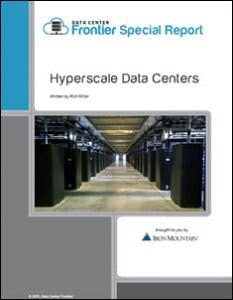Data Center Frontier continues to explore the fastest growing markets and niches in the data center market via our DCF Special Reports. This time around, Data Center Frontier partners with Iron Mountain to explore the hyperscale data center market, and how its growth has changed how we compute. This excerpt from a recent Hyperscale Data Center report highlights the impact of major growth of hyperscale computing for data service providers, as well as the future of hyperscale.
Download the full report.
The growth of hyperscale computing has major implications for data center service providers, driving segmentation within the service provider universe. Wholesale providers that aspire to compete for hyperscale deals have worked to optimize their supply chains and construction operations to deliver capacity at the cost, speed and scale these customers require.
Enterprise interest in cloud connectivity has also influenced the retail colocation sector, placing a premium on interconnection and cloud “on-ramps” to support hybrid IT strategies.
Here’s a look at some of the ways the influence of hyperscale customers is changing the game for service providers and developers.
Deal Size
Prior to 2016, deals larger than 10 MWs were rare. In 2018 there were 11 deals of 10 MWs of more in 2018, according to North American Data Centers, including a whopping 72 MW lease in Northern Virginia. These deal sizes require different approaches to inventory and construction. Some providers are optimizing designs based on hyperscale requirements for Availability Zones.
Vertical Construction
Larger deals have also brought more multi-story construction, particularly in property-constrained markets. Building vertically allows developers to maximize the square footage on each acre of property. The most prominent example is Facebook’s 1.8 million SF project in Singapore, which features an 11-story purpose-built data center structure. More typical is the shift to three-story designs in Ashburn and four-story buildings in Santa Clara.
Land Banking
Hyperscale operators are focused on long-term growth, which is prompting developers to pursue “land banking” strategies, acquiring land for future projects in markets where development sites are scarce. This practice has accelerated in regions like Northern Virginia, Silicon Valley and Phoenix, where developers are locking down land amid rising prices and a dwindling supply of premium sites.
Hyperscale operators are focused on long-term growth, which is prompting developers to pursue “land banking” strategies, acquiring land for future projects in markets where development sites are scarce.
Speed to Market
The challenges of capacity planning created an opportunity for wholesale providers who could deliver space more quickly. This has brought innovation in construction, including a larger focus on pre-fabricated components and lean construction. Developers are also optimizing their supply chain, typically by bulk-ordering equipment with a long lead time for delivery (like generators and UPS units) and storing them in warehouses for rapid deployment.
Deal Structures
Leasing strategies are also becoming tools to win hyperscale deals. Recent hybrid deals combine elements of build-to-suit projects and speculative builds. Tenants lease a large powered shell, gaining control of the entire building so they don’t have to worry that it will be leased to competitors. The tenant then can add capacity quickly, with the landlord building new data halls as the tenant needs the capacity—rather than when space is available on the developer’s next building or campus. Developers and tenants are also discussing more right-of-first-offer vehicles on data halls and land, as well as lease-to-purchase options.
Relationships and experience will be more important than ever. Hyperscale operators want dependability in delivery, and consistency in design and performance. They are increasingly seeking partners rather than just vendors.
This special report series also covered the following topics. Catch up on the series below:
- Reshaping the Global IT Landscape: The Impact of Hyperscale Data Centers
- Who are the Data Center’s Industry’s Hyperscale Players?
- How Hyperscale Customers & Data Centers are Unique
Download the full report, “Hyperscale Data Centers,” courtesy of Iron Mountain Data Centers, to learn more about how hyperscale computing has changed the supply chain for digital infrastructure, and how this computing shift will evolve.







